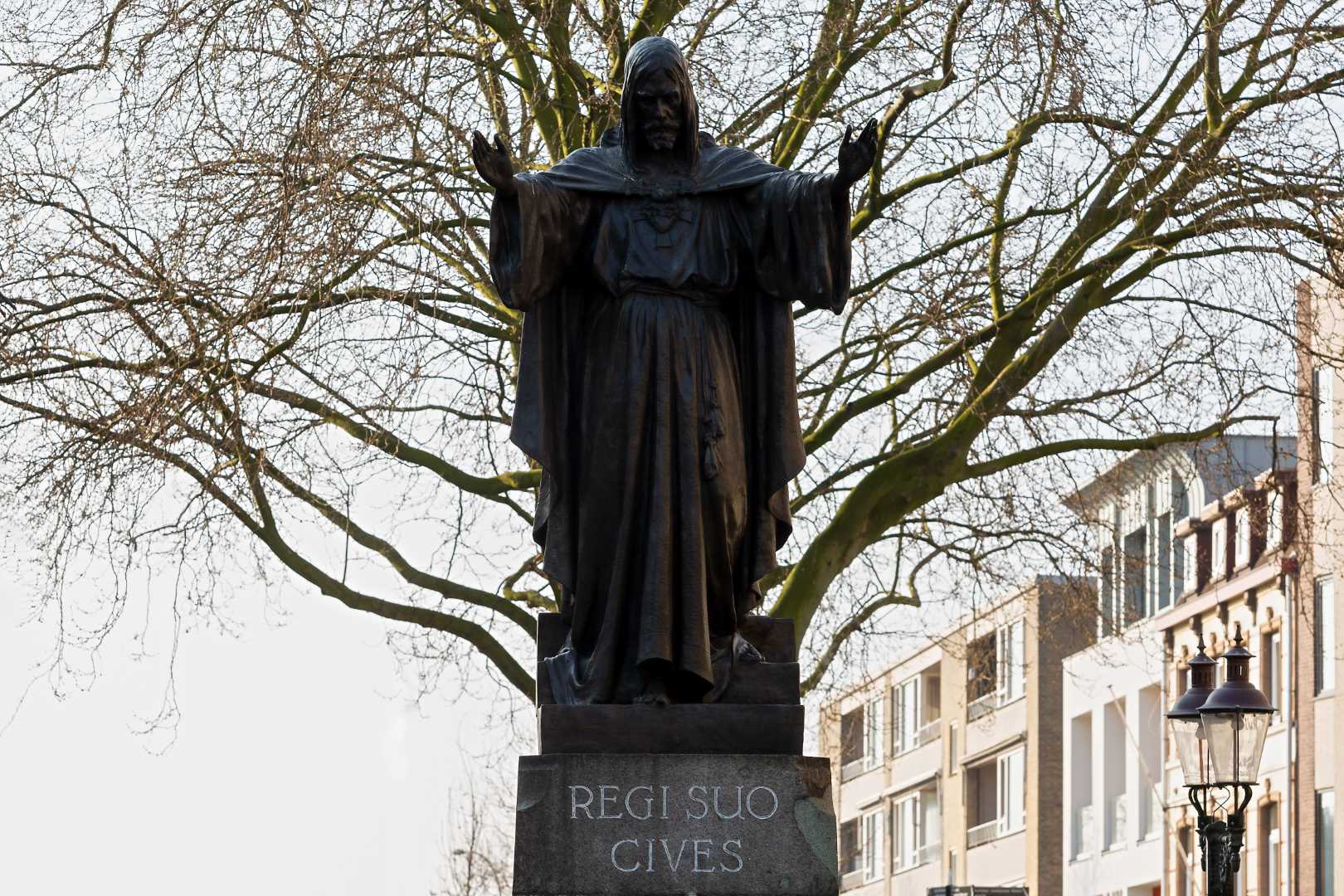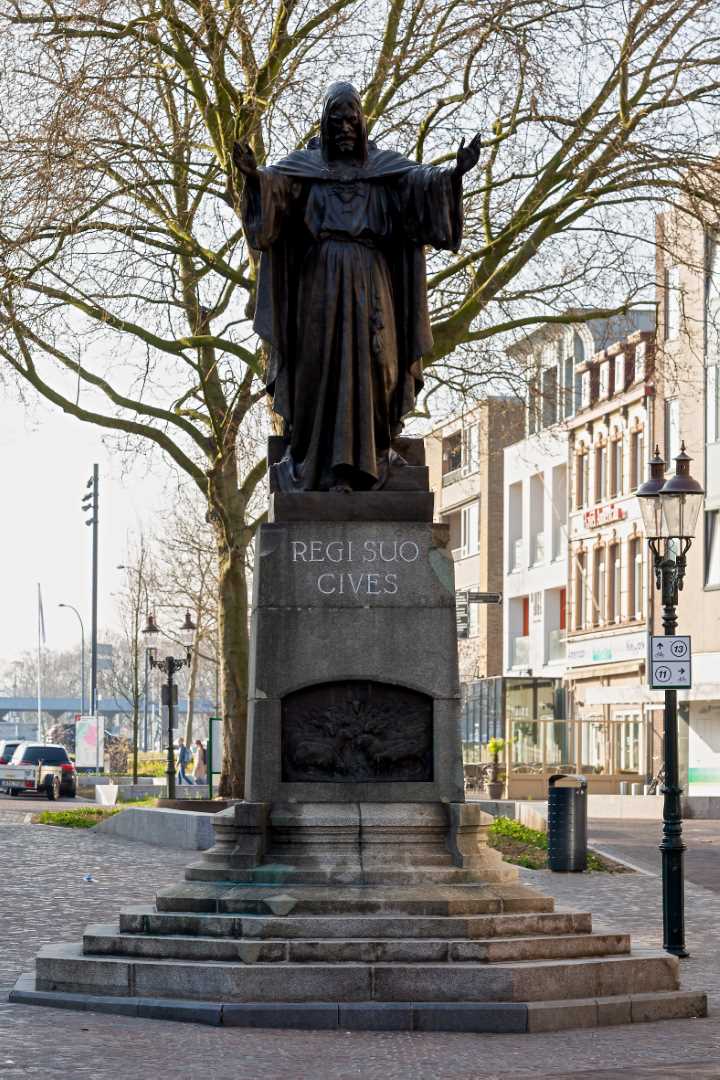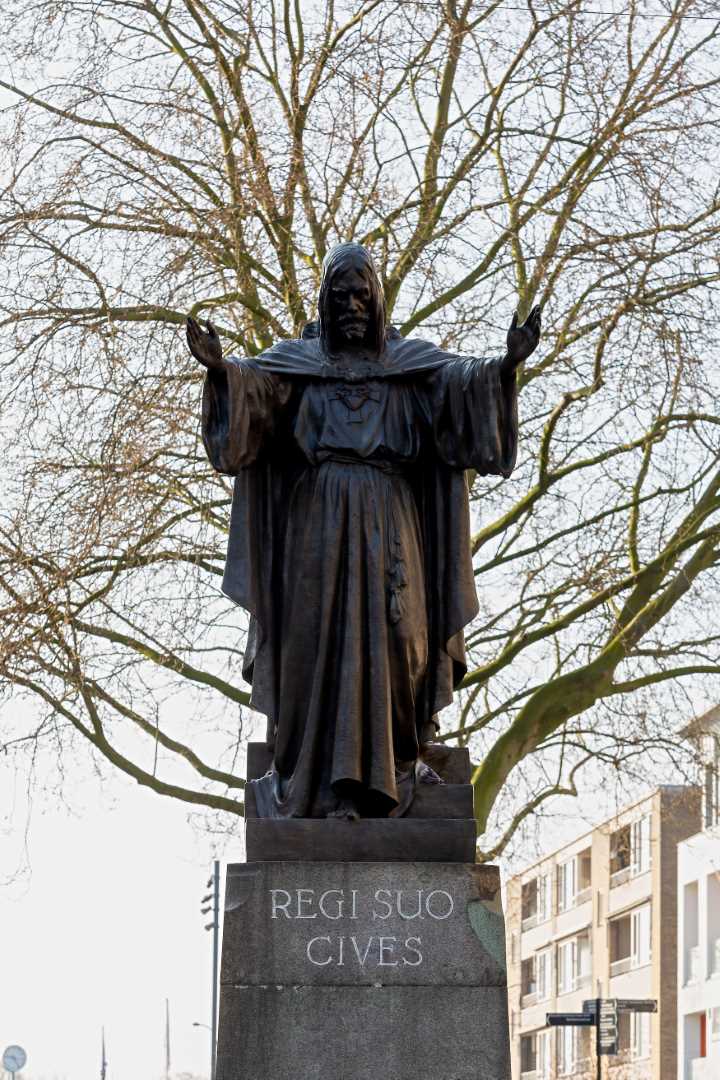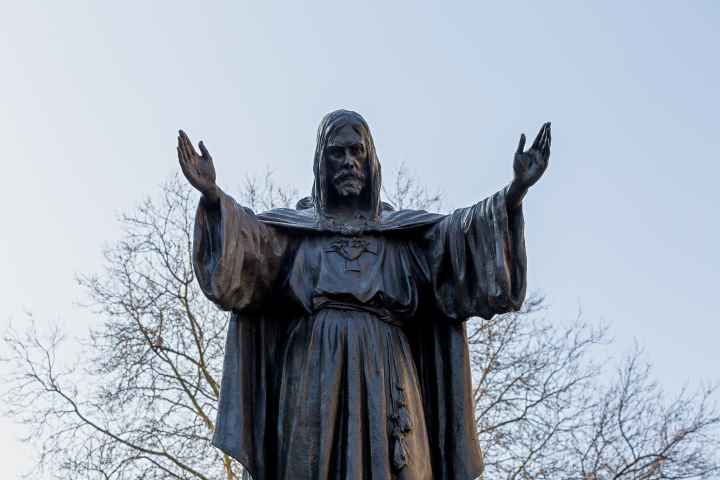Sacred Heart Statue
Keulsepoort
Sacred Heart Statue – August Falise
The Sacred Heart statue in Venlo is a statue made by August Falise. From 1920 and onwards, Falise made various Sacred Heart statues of this kind, commissioned by the Catholic Church. The standing figure of Christ is dressed in a robe and wrapped in a cloak. He raises both his hands in blessing, showing the stigmata. On his chest is the Sacred Heart. The statue stands on a granite pedestal, on which there is an inscription showing the text Regi Suo Cives (the citizens to their king). It stands facing the city with the aim of protecting the inhabitants.
The statue is located at the Keulsepoort and was unveiled on 5 June 1921 by Bishop Laurentius Schrijnen of Roermond, in the presence of Mayor Van Rijn and others.
In the course of 2021, a century after it was placed, the statue temporarily disappeared from its pedestal. In that period, it was fully cleaned and restored, partially for the redevelopment of the Keulsepoort.
The artist: August Falise
Augustinus Franciscus Henri Falise (1875-1936), from Wageningen, was a Dutch sculptor and medallist. From 1891, Falise was educated in medalling, sculpture, hand drawing and modelling at the Amsterdam School of Arts and Crafts. He learned bronze casting in Cologne and Liège. He subsequently attended the small (1900-1901) and large sculpture class (1901-1902) at the Rijksakademie van beeldende kunsten. He was subsequently artistic director at N.V. Terracotta and Earthenware Factory Haga in The Hague until 1904, after which he became a designer for Plateelbakkerij Haga in Purmerend.
As an independent artist, Falise initially concentrated on making medals and tokens, as well as small-scale sculptures. His debut sculpture ‘The Young Slave’ (1901) can be seen in Nijmegen in the Museum Het Valkhof (ceramics basement). His early work lives and breathes the atmosphere of Dutch impressionism. Later, he made monuments and statues on commission. From 1920, he also designed Sacred Heart statues at the request of the Roman Catholic Church. The theologian Father Titus Brandsma, a friend of Falise’s, was responsible for several of his commissions. Falise’s statues include Jheronimus Bosch in Den Bosch, Thomas Aquinas in Nijmegen, Schaepman in Tubbergen, Pierre Cuypers in Roermond and De Zaaier in Wageningen.
In 1915, Falise became a teacher of drawing and modelling at a secondary school in Nijmegen and later at the Royal School for Useful and Visual Arts in ‘s-Hertogenbosch.
In 1930, he received the first Hieronymus Bosch medal, the cultural prize of Den Bosch. He received various Dutch and foreign honours, including the papal Order of Gregory and the Belgian Crown Order in 1936.
De Keulsepoort (The Keulse Gate)
As one of the four main gates, the Keulsepoort was part of the fortifications of the city of Venlo (built between 1340 and 1345). In the 19th century, these fortifications – like those of many other Dutch cities – became so constricted that it was decided to demolish them. That happened between 1867 and 1872. Work at the site in 2011 revealed that the foundations of the gate are still intact underground.
After the city walls were demolished, the Köln-Mindener railway line was built at Cologne Gate and what is now the (adjacent) Juliana Park. This was a German railway line that was part of the Hamburg-Paris route. Just before the Second World War, near the foundations of the Keulsepoort, the building was constructed that served as a post office for a very long time, but nowadays houses the Van Bommel van Dam Museum.
The railway track disappeared after the war and was replaced by Julianapark. After that, the Keulsepoort was one of the access roads for car traffic to the inner city for several decades.
That road was closed off at the end of the last century, after which the Keulsepoort became a square. In 2000, the Limburgs Museum was built on that square, and in 2021, the Van Bommel van Dam Museum opened its doors in the adjacent, former post office, after having been located on the Deken van Oppensingel, a few hundred metres away, for about fifty years.
That building was specially built for the museum and also housed the two founders, Maarten and Reina van Bommel-van Dam. In 2021, a start was also made on the redevelopment of the Keulsepoort, which has been given a greener character, among other things. Because of the presence of the two museums, the Keulsepoort is often called Museumplein in popular speech. Opposite the Limburgs Museum is a building that was originally one of the oldest and perhaps the oldest petrol stations in the Netherlands. It dates from 1933 and belonged to the American Petroleum Company (later Esso). Nowadays, one can eat some ice cream there.




